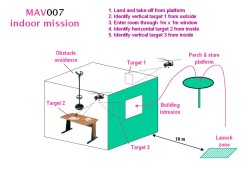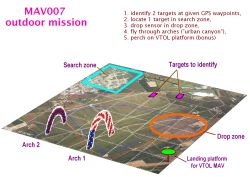Last news for competitors
A Map is available with the conference and competition sites.
The list of competitors has been updated.Flight Competition
Two challenging missions will be open to MAVs of which the maximum dimension is 500 mm and maximum weight is 500 grams. Competitors are welcome to take part to either or both flight sessions. There is no requirement to use the same vehicle for the outdoor and the indoor missions.
For the two missions, the competitors will have to follow General Rules (also available as a PDF file)
Indoor flight session
The indoor flight session will consist of conducting a spy mission by flying a MAV into a 3.6-meter square room through a 1-meter square window and identify two targets only visible from inside, one located on a table and one posted on a wall. A coat-hanger will be randomly placed in the room to test the obstacle avoidance capability. The operator will have to stay within the launch zone at 10 meters outside the room.
Download description (PDF)
Download the scoring sheet (PDF)
More:
- Working time is 10 minutes.
Indoor Judges Panel
![]() Aurelia AUTRAN, Mini-UAV system engineer, French MoD Procurement Agency (DGA), France
Aurelia AUTRAN, Mini-UAV system engineer, French MoD Procurement Agency (DGA), France
![]() Christian BOLLER, Professor in Smart Structural Design, University of Sheffield, UK
Christian BOLLER, Professor in Smart Structural Design, University of Sheffield, UK
![]() John JOHNSON, Aviation and Missile Technology, U.S. Army International Technology Center-Atlantic, London, UK
John JOHNSON, Aviation and Missile Technology, U.S. Army International Technology Center-Atlantic, London, UK
![]() Surya SURAMPUDI, European Office of Aerospace Research and Development, UK
Surya SURAMPUDI, European Office of Aerospace Research and Development, UK
![]() Hiroshi TOKUTAKE, Dept of Aerospace Engineering, Osaka Prefecture University, Japan
Hiroshi TOKUTAKE, Dept of Aerospace Engineering, Osaka Prefecture University, Japan
Outdoor flight session
The outdoor flight session will consist of flying an MAV over two separate 1.2X1.5- meter placards within a 1 kilometer radius and identify them. A third identified placard will have to be accurately located within a given area. A circular platform of 1.2-meter diameter will be placed at 1.5m from the ground to demonstrate vertical take-off and landing capabilities of rotorcraft MAVs. Finally, the MAV will have to fly through an urban canyon made of two balloon arches before landing in a predefined zone.
Download description (PDF)
Download The Outdoor-Layout (Word)
Download The Outdoor-Layout (PDF)
Download the scoring sheet: Word or PDF
More:
- The sensor to drop is a classical paintball (weight: 3.5 grams ; diameter: 17 mm).
- The working time is 20 minutes
- Targets to be identified will be characters of the roman alphabet, printed in Arial Bold font, about 80cm high.
Outdoor Judges Panel
![]() Gregg ABATE, US Air Force Research Laboratory Munitions Directorate, FL, USA
Gregg ABATE, US Air Force Research Laboratory Munitions Directorate, FL, USA
![]() Nicolas DUFETELLE, UAV Executive, French MoD Procurement Agency (DGA), France
Nicolas DUFETELLE, UAV Executive, French MoD Procurement Agency (DGA), France
![]() Patrick FABIANI, Head of Control & Flight Dynamics Dept, ONERA, France
Patrick FABIANI, Head of Control & Flight Dynamics Dept, ONERA, France
![]() Tim McLAIN, Chair of Dept of Mechanical Engineering, Brigham Young University, UT, USA
Tim McLAIN, Chair of Dept of Mechanical Engineering, Brigham Young University, UT, USA
![]() Evgeny SOKOLOV, Head of Laboratory, Central Research and Developing Institute of Robotics and Technical Cybernetics, Russia
Evgeny SOKOLOV, Head of Laboratory, Central Research and Developing Institute of Robotics and Technical Cybernetics, Russia
Competitors information
Technology Demonstrations open to mini-UAVs under 1 meter and 2 kilograms will allow to demonstrate novel, cutting-edge technologies as applied to indoor and outdoor MAVs. An MAV record-breaking contest will be open to competing teams who are willing to ratify a specific achievement relevant to MAV technologies.
e.g.: the smallest RC rotorcraft, the smallest RC ornithopter, etc.
Technical papers for competitors : Competing teams are invited to provide a technical paper which describes the rationale behind their design choices. A post-flight experience session will allow each team to briefly give an account of their flight.
Sponsorship : A limited number of grants partially covering travel expenses may be made available during the application process upon request. Under availability of funds, some travel expenses, such as flight tickets (in economy class) and accomodation up to two persons will be covered for selected teams.
Deadlines
- From April 16, 2007Statement of Intention to Participate
April 16, 2007Extended to May 9Sponsorship applicationApril 16, 2007Extended to May 9MAV record-breaking proposal- July 2, 2007Registration for competitors and tech demos
A statement of intention to participate is a letter or an electronic message which includes: the names and addresses of potential team members, name of institution, name of the team/MAV system, and a short description of the system to be presented. Please specify at which session you intend to take part: indoor mission, outdoor mission, indoor tech demo, outdoor tech demo.
Sponsorship application consists of:
- A statement of intention to participate
- A 2-page abstract in pdf format describing the MAV system to be presented.
Safety Regulation
For the outdoor mission, the authorized frequencies are the following:
26 MHz, 41 MHz, 72 MHz: max power 100 mW
2.4 GHz and 868 MHz: max power 500 mW
All micro air vehicles must be equipped with safety devices which allow the pilot to keep full control of the MAV at any time during the flight by switching back to manual mode through a priority uplink.
All MAVs must be equipped with an on-board GPS receiver and a transmitter which sends GPS coordinates in real-time mode down to the ground station.
A flight zone will be defined in advance. During the outdoor flight session (outdoor competition or outdoor technical demonstrations), all MAVs should remain within the limits of the flight zone. If a MAV crosses the borders of the flight zone, the pilot must immediately switch off the motor.
The flight zone is inside a security zone. A MAV must never get out of this zone (even when the motor is off). So the flight zone must be computed from the coordinates of the security zone according to the performances of the MAV and the wind (e.g. a glider would have a smaller flight zone than a rotorcraft). The coordinates of the security zone (displayed in the Google Map) are given in the following table:
| Lat (deg) | Long (deg) |
| 43.5389 | 1.2433 |
| 43.5425 | 1.2469 |
| 43.5447 | 1.2511 |
| 43.5447 | 1.2636 |
| 43.5358 | 1.2608 |
| 43.5328 | 1.2581 |
Furthermore, a safety evaluation memo will be sent to the Organizing Committee to demonstrate that the probability to exit a given flight zone is less than 0.0001 per hour. Safety devices will be displayed during the static judging session.

